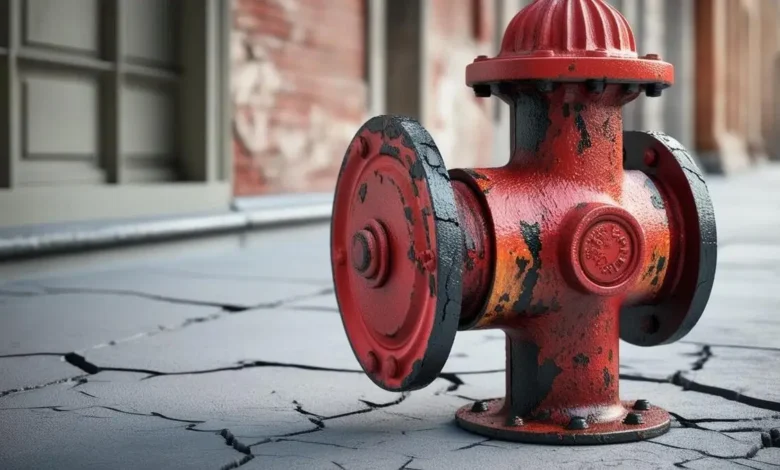
Every town and city relies on fire hydrants because they provide a source of water in case of a fire emergency. They are important not only for public safety but also for many artistic purposes, decorative usage, and even filmmaking, especially with their older look.
But making a fire hydrant look aged is not everyone’s cup of tea. It requires implementing appropriate strategies. But if you don’t know how to do that, do not worry because, in this article, we will discuss the best and easiest techniques for aging an Iowa fire hydrant.
So, let’s walk through the instructions together in compliance with local laws on how to age a fire hydrant. Shall we?
Reasons Why Someone Would Want to Age a Fire Hydrant
Before jumping headfirst into the process of aging fire hydrants, one should first understand why someone would want to take that step. So, based on our research, here are the major reasons:
- Artists and designers often work with hydrants for creative displays.
- Creating a realistic scene that requires aged infrastructure.
- To beautify themed public parks or private gardens.
- To maintain the vintage aesthetic of fire hydrants located in older neighborhoods or historic districts.
Steps and Method for How to Age an Iowa Fire Hydrant
By now, you may have understood the reasons for aging an Iowa fire hydrant. If so, let’s now get to the methods.
To put everything in a few words, aging a fire hydrant requires a combination of the following:
- Chemical treatments.
- Paint techniques.
- Exposure to natural elements.
So, with that in mind, follow the steps mentioned below carefully to achieve a realistic aged look:
Step # 1: Check Local Fire Hydrant Regulations
Always check with your local authorities before altering a fire hydrant. Why?
Well, simply because many cities and counties in Iowa have strict rules about modifying public fire hydrants, as outlined by the Iowa Department of Public Safety. However, if you’re working with a privately owned hydrant, ensure you have the proper permissions.
So, here are two regulations regarding fire safety regulations for buildings of different heights:
1. Multi-Storey Buildings (4 to 10 Floors)
These types of buildings need to have an internal fire hydrant and pressurized system. That system must be fed by an independent overhead water tank of 7,500 gallons at the least and an underground external tank of 15,000 gallons at a minimum.
2. Structures of More Than Ten Storeys
These structures need a standalone aboveground tank with a capacity of 15,000 gallons and an external underground tank with a minimum volume of 30,000 gallons. Fire engines must always have unobstructed access to the external underground tank.
Step # 2: Clean the Surface Thoroughly
Once you’ve verified the local fire hydrant regulation, the next thing you need to do is to remove dirt, rust, or old paint layers. For effective results, you may have to use a pressure washer or wire brush. But why do you need to perform this cleaning?
Well, a clean surface allows for better adherence to paint and aging treatments. So, clean the surface of a fire hydrant, possibly in a low-water area. And here is a step-by-step guide for that:
- First, gather the following supplies:
- Bucket of water or hose (if available).
- Mild detergent or degreaser.
- Protective gloves.
- Rags or sponges.
- Rust remover (if needed).
- Stiff-bristled brush.
- Wire brush (for rust).
- Then, scrub off buildup, cobwebs, and dirt using a stiff-bristled brush. If there’s rust, use a wire brush to remove it.
- As for step 3, it is time to scrub the hydrant. Grab a pigmented detergent and mix it with water. Afterward, grab a rag or sponge and scrub the hydrant. For tougher grime, let the detergent soak it for a few minutes before washing.
- Step number four is rinsing off the soap. This can be done either with a hose or with a bucket of water. If you live in a region that is known for having a low water supply, then a damp cloth can be used.
- When there is any rust present, treat it right away. First, apply rust remover and then use a wire brush to scrub the rust spots. With the scrubbing over, wipe them down with a dry rag.
- Lastly, you need to dry and inspect. So, wipe the hydrant dry first to prevent new rust from forming. Then, inspect for leaks, damage, or faded paint.
Step # 3: Apply a Base Layer of Aged Paint:
To make the hydrant look naturally aged, follow these simple series of instructions:
1. Checking the Condition of Paint
If the paint is slightly aged but the condition is okay, then cleaning it may be the thing to do. If the paint is chipped, flaking, or has rust underneath, then that needs to be removed before repainting.
2. Cleaning the Surface
- Grab a stiff-brushed cleaner and start scrubbing gently to remove any dirt and/or loose debris.
- Next, for any oil or dirt, wash the surface with warm water in addition to lighting soap or use a degreaser.
- When you finish, allow it to dry thoroughly before continuing.
3. Stripping Old Paint Off (If Required)
- With a paint scraper or a wire brush, strip off all the loose pieces of paint. You can also use a wire wheel on a drill or grinder to remove paint much faster because it is more efficient.
- Let it sit for the recommended amount of time.
- A paint stripper made for metal surfaces should work well. So, remove the softened paint afterward. This can also be done through sandblasting, which is the fastest method to turn a hydrant to bare metal.
4. Dealing with Rust
For stubborn rust spots, use a rust remover or naval jelly. So,
- Sand down rusty areas with sandpaper or a wire brush.
- Then, wipe clean with a dry cloth.
5. Applying a Base Layer (Primer)
- Choose a rust-inhibiting metal primer.
- Then, apply an even coat using a brush or spray.
- Finally, let it dry completely before applying the topcoat.
6. Repainting
- Use high-visibility, weather-resistant paint, typically red or yellow.
- Then, apply multiple thin coats for durability.
- Lastly, let the base coat dry completely before proceeding.
Step # 4: Use Rust-Enhancing Solutions:
For a realistic aging effect, apply a rust activator or a homemade rusting solution. Here’s how:
- First, mix hydrogen peroxide, vinegar, and salt to create an instant rusting effect.
- Then, brush or spray the solution onto metal surfaces and let it sit for a few hours.
- Finally, rinse lightly to prevent excessive corrosion.
Step # 5: Add Weathering Details
Once the hydrant has started developing a rusted look, enhance the aging with the following approaches:
1. Chipping Effects
Lightly sand areas to mimic peeling paint.
2. Dirt and Grime Application
Use a mixture of brown paint and water to add streaks of dirt.
3. Dry-Brushing Techniques
Use a small amount of lighter paint to highlight edges and worn-out areas.
How to Allow Natural Exposure After Aging an Iowa Fire Hydrant?
For a truly authentic, aged look, place the hydrant in an area exposed to the following sections for a few weeks:
- Humidity.
- Rain.
- Sun.
These natural elements will enhance the weathered effect over time.
Final Words
If you’ve followed the entire above-specified discussion, you may have known how to age an Iowa fire hydrant by now. If so, you will now be able to confidently transform a modern hydrant into a rustic, vintage piece. So, whether it’s for art, decorative use, or historical preservation, these techniques will help you achieve a realistic aged look while keeping the hydrant structurally intact. But remember to always check with local regulations before modifying public hydrants.



